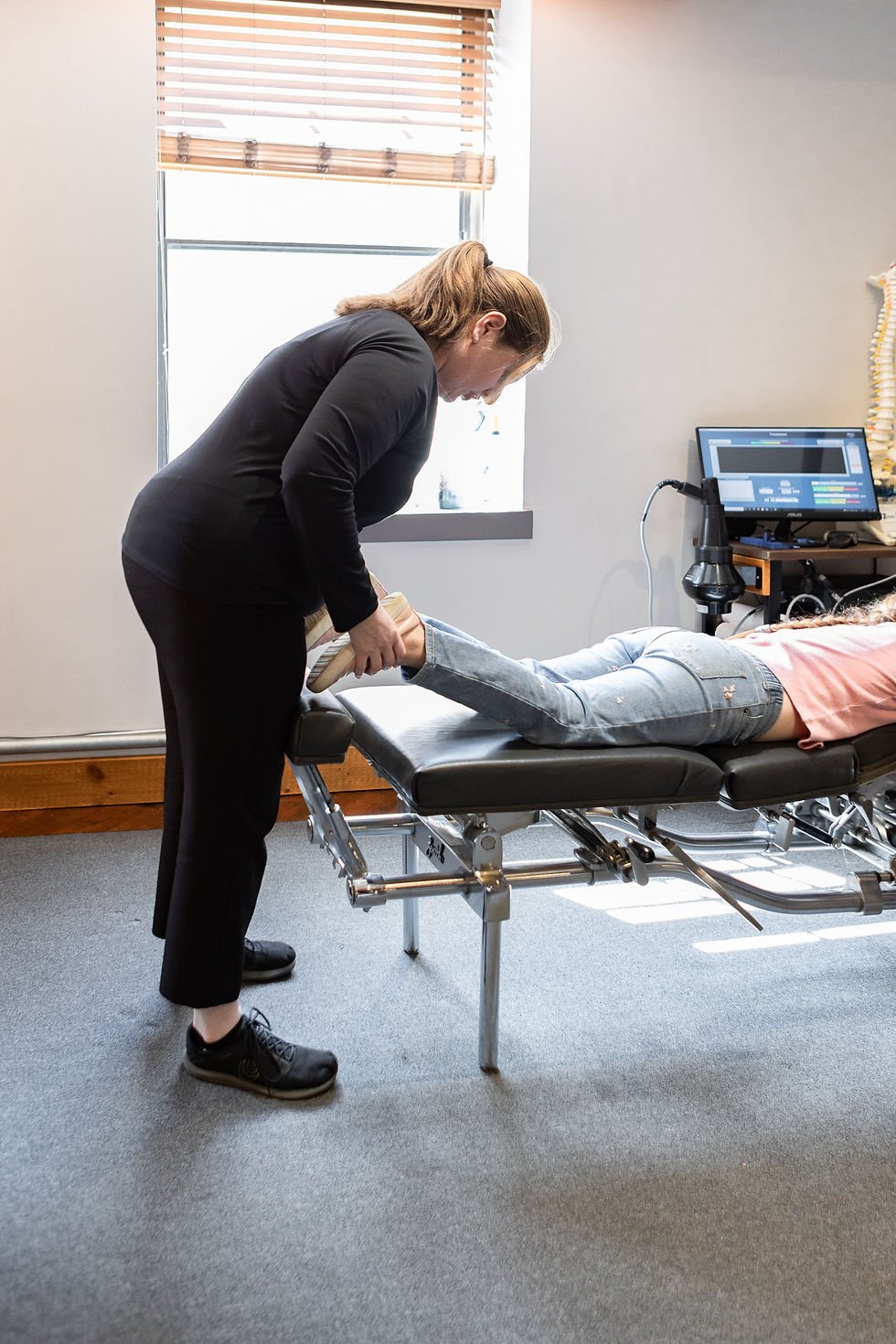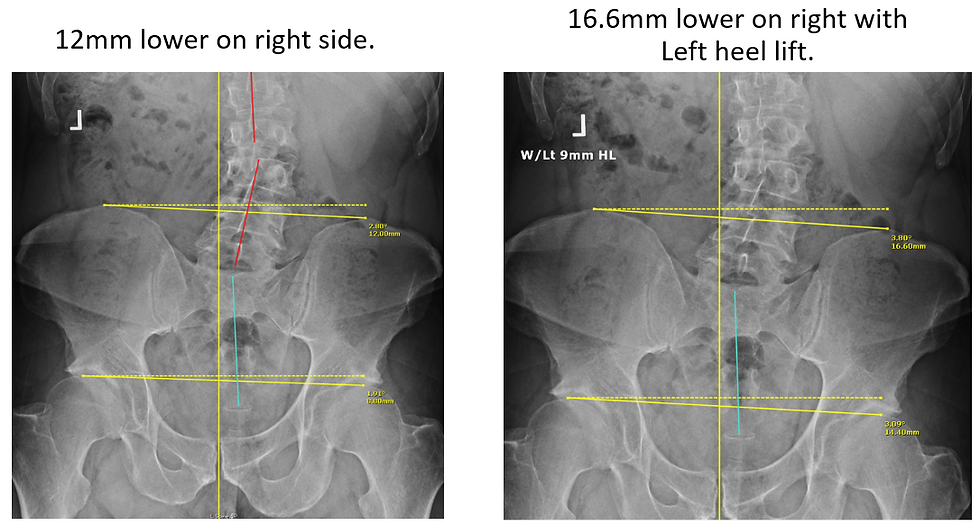Heel Lifts: A Foundation for Lasting Relief at OWL Chiropractic
- Dr. Emilie

- Jul 22
- 5 min read

Are you experiencing persistent pain in your SI joint, pelvis, or hips? You might be surprised to learn that the root cause could be an uneven pelvis. At OWL Chiropractic, we've seen firsthand how a seemingly small imbalance can lead to significant discomfort and dysfunction in the nervous system. One solution that often comes into play, when appropriate, is the use of heel lifts.
What is a Heel Lift and Why Might You Need One?
Simply put, a heel lift is a small insert placed inside one shoe, designed to subtly raise one side of your body. Its purpose is to address a leg length discrepancy, which can lead to an uneven pelvis. When your pelvis is misaligned, it puts undue stress on the surrounding joints, muscles, and nerves, often manifesting as pain in your lower back, SI joint, and hips. Pelvic misalignments can stem from a variety of factors:
Major or Repetitive Trauma: Even seemingly minor incidents, especially those experienced during childhood, can contribute to long-term structural imbalances. Think of countless sports injuries, falls, or even prolonged poor posture.
Knee, Hip, or Ankle Replacements: Surgical interventions in these joints can sometimes alter the length or mechanics of the limb, leading to a functional leg length difference.
True Different Length Legs: While rare, some individuals are born with a slight difference in the actual bone length of their legs.
Why X-rays are Essential for Assessing Pelvic Alignment
You might think a simple visual check of leg length is enough to determine if your pelvis is uneven. However, at OWL Chiropractic, we firmly believe that X-rays are superior and crucial for an accurate assessment. Why? Because visually checking leg length can be misleading. Factors like muscle tension, joint restrictions, and even the way someone stands can create the appearance of a leg length difference when the underlying issue is a pelvic torsion or rotation. X-rays provide a precise, objective measurement of your skeletal structure, allowing us to see exactly how your pelvis, sacrum, and lumbar spine are aligned. This precision is paramount in determining if a heel lift is truly needed and, if so, the exact measurement required.
Our Approach: Adjustments First, Heel Lifts Second
At OWL Chiropractic, our philosophy is to address the root cause of your pain through comprehensive chiropractic adjustments. In most cases, we like to begin with a course of adjustments before prescribing a heel lift. This is because changes in the cervical spine (neck) can often have a profound ripple effect, leading to improvements in the alignment of the lumbar spine (lower back) and pelvis. Sometimes, these initial adjustments are enough to resolve symptoms, eliminating the need for a heel lift altogether.
We typically assess the need for a heel lift after 8-12 visits. However, if symptoms persist, we may consider adding a heel lift later in your care plan. When we prescribe a heel lift, we take before and after X-rays to ensure that the lift not only improves the alignment of your pelvis but also positively impacts your sacrum and lumbar spine. We then guide patients through a two-week easing-in period to allow their body to adapt. In the vast majority of cases, this thoughtful approach leads to significant improvement in symptoms. Occasionally, a heel lift may not provide the desired relief, in which case we remove it.
If a heel lift improves alignment and reduces your symptoms, it's highly likely that this will be a lifelong adaptation. It's a small $12 investment that can bring immense relief, and we encourage patients to wear it as often as possible.
Here are two powerful examples of how heel lifts, guided by precise X-ray analysis, have transformed lives at OWL Chiropractic:
Case 1: A Professional Athlete’s Misplaced Lift

This first case highlights the critical importance of accurate diagnosis. We had a 44-year-old former professional athlete come to us with debilitating low back pain and sciatica radiating down to his left heel. His initial exam revealed that his right iliac crest (top of the pelvis) was 12mm lower than the left side. However, the patient informed us he had been wearing a 9mm heel lift on his left side, prescribed by his professional sports team's medicine doctor.
We took an X-ray with his existing heel lift in addition to our standard x-ray series. The images revealed a shocking truth: he had been wearing the heel lift on the wrong side for almost 15 years, which had actually increased the gap to 16.6mm and likely contributed to a significant curvature in his lumbar spine.

After just 8 visits, and removed the left heel lift, the patient reported a remarkable decrease in his symptom. We then took an X-ray with a 9mm heel lift placed on his right side, which reduced the gap between his pelvis to just 5.4mm and significantly improved the overall biomechanics of his spine. After 18 visits and now wearing a heel lift on the appropriate side, the patient reported complete resolution of his left sciatica. Most importantly, he reports being able to participate in weekend-long sports camps with his kids. While his lower back still gets sore after these demanding weekends, he emphasizes that prior to our care, he wouldn't have been able to walk for days afterward. This patient is now able to continue with the sport he loves and play with his children without the fear of his lower back giving out.
Case 2: A New Knee, A New Problem, A New Life
This next case again underscores the absolute necessity of X-rays. A 67-year-old female presented to us with severe low back pain and sciatica. She arrived using a walker, driven by her husband, in extreme pain and visibly distressed. She had undergone her third knee replacement on her left knee the previous year and had been diligently attending physical therapy twice a month with no relief.

Her initial X-ray provided immediate clarity: her new left knee had caused her left hip bone to be a startling 20mm higher than her right. No wonder she was in such agony! After 18 visits over three months, we had reduced the gap to 18mm, and the patient reported improved sleep and significantly reduced low back pain. She had also progressed to using only a cane to get around. At this point, due to the persistent discrepancy caused by her knee replacement, we prescribed an 18mm heel lift for her right side. This brought the gap down to a much-improved 9mm.
After continued care, the patient began walking into our office happy, by herself, and with no walking assistance. She tearfully expresses how she's able to play with her grandchildren again, stating that we have given her her life back. In all honesty, witnessing these types of "miracles" on a weekly basis is precisely why I love my job so much.
At OWL Chiropractic, we believe in a precise and personalized approach to your well-being. If you're struggling with persistent low back, SI joint, or hip pain, an uneven pelvis might be the underlying cause. Through meticulous X-ray analysis and a thoughtful adjustment-first strategy, we can determine if a heel lift is the right solution to restore your body's natural balance and alleviate your discomfort.
Don't let chronic pain limit your life; contact OWL Chiropractic today to discover how a simple heel lift, combined with expert chiropractic care, could be the key to regaining your freedom and enjoying the activities you love, just like the patients in our success stories.




Comments